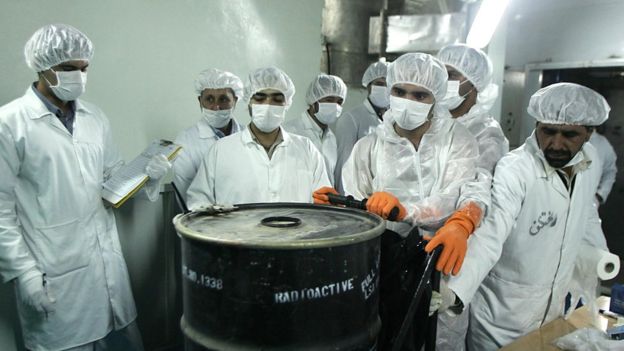Iran says it has begun work on increasing its uranium enrichment capacity, in case its 2015 nuclear deal with world powers collapses.
The head of Iran’s atomic agency told reporters it was developing infrastructure to build advanced centrifuges at the Natanz facility.
The agency says it is officially notifying the United Nations’ nuclear agency about the move in a letter.
President Donald Trump withdrew the US from the deal with Iran last month.
The head of Iran’s Atomic Energy Organisation, Ali Akbar Salehi, told reporters on Tuesday that preparations were under way to build new centrifuges.
“If we were progressing normally, it would have taken six or seven years, but this will now be ready in the coming weeks and months,” he said.
The work will enable Iran to make more uranium hexafluoride – a key ingredient in the enrichment process.
Mr Salehi said this was in line with instructions from Supreme Leader Ayatollah Khamenei, who has ordered officials to be prepared to step up enrichment if the nuclear deal – known as JCPOA – falls apart completely.
“If the JCPOA collapses – please pay attention, if the JCPOA collapses – and if we decide to assemble new centrifuges, we will assemble new-generation of centrifuges. However, for the time being, we move within the framework of the JCPOA,” Mr Salehi said.
Is such work allowed under the accord?
Mr Salehi insists Iran is acting “within the framework of the rules and commitments of the nuclear deal”.
The accord signed with the US, France, Germany, the UK, Russia, and China, limits uranium enrichment by Iran to 3.67%, far below the roughly 90% threshold of weapons-grade material.
In exchange, the country received relief from crippling sanctions.
Under the agreement, Iran can build parts for the centrifuges as long as it does not put them into operation within the first decade.
President Trump argued that these conditions did not go far enough to curb Iran’s nuclear ambitions and pulled out of the agreement, leaving the remaining European signatories scrambling to save it.
Iran insists its nuclear programme is entirely peaceful. Its compliance with the deal has been verified by the IAEA.
What is the purpose of the Natanz facility?
It is Iran’s largest uranium enrichment facility, and began operating in 2007 in contravention of UN Security Council resolutions.
It consists of underground buildings capable of holding up to 50,000 centrifuges. Uranium hexafluoride gas is fed into centrifuges, which separate out the most fissile uranium isotope U-235.
The facility produces low-enriched uranium, which has a 3%-4% concentration of U-235.
That can be used to produce fuel for nuclear power plants, but also be enriched to the much higher level of 90% needed to produce nuclear weapons.
Source: BBC



